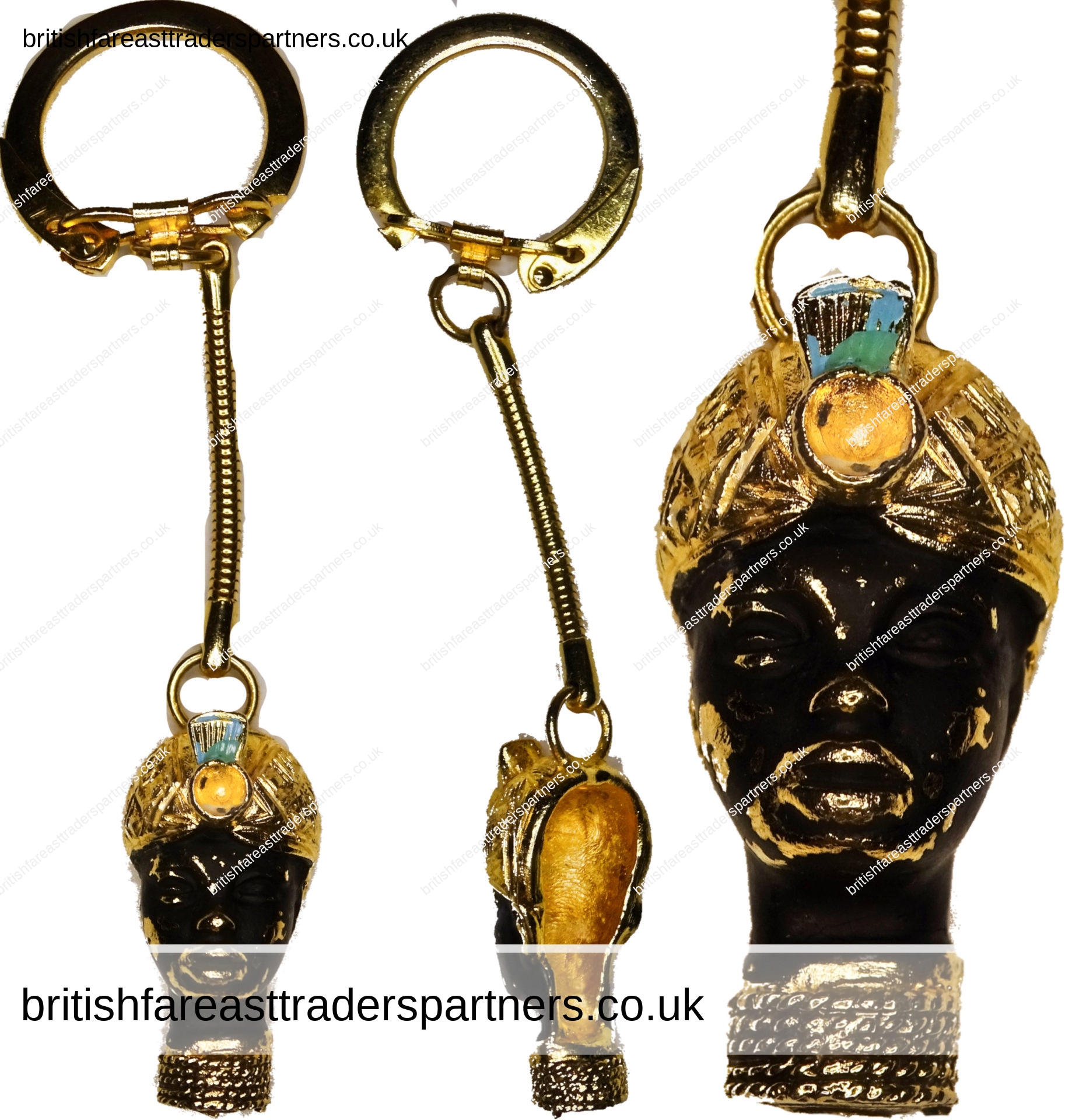Last Updated on: 17th December 2021, 07:32 pm

VINTAGE BLACKAMOOR
BLACK, GOLD & Enamel
AFRICAN Queen
NUBIAN QUEEN Princess Lady
COLLECTABLE KEY RING
SUPPLEMENTAL READING:
History
The prehistory of Nubia dates to the Paleolithic around 300,000 years ago.
By about 6000 BC, peoples in the region had developed an agricultural economy.
They began using a system of writing relatively late[according to whom?] in their history,
when they adopted the Egyptian hieroglyphic system.
Ancient history in Nubia is categorized according to the following periods:[17]
A-Group culture (3700–2800 BC),
C-Group culture (2300–1600),
Kerma culture (2500–1500),
Nubian contemporaries of the New Kingdom (1550–1069),
the Twenty-fifth Dynasty (1000–653),
Napata (1000–275),
Meroë (275 BC–300/350 AD),
Makuria (340–1317),
Nobatia (350–650), and
Alodia (600s–1504).
The linguistic affinities of early Nubian cultures are uncertain.
Some research has suggested that the early inhabitants of the Nubia region,
during the C-Group and Kerma cultures were speakers of languages
belonging to the Berber and Cushitic branches respectively,
of the Afroasiatic family.
More recent research instead suggests
that the people of the Kerma culture
spoke Nilo-Saharan languages of the Eastern Sudanic branch,
and that the peoples of the C-Group culture
to their north spoke Cushitic languages.[18][19][20][21]
They were succeeded by the first Nubian language speakers,
whose tongues belonged to another branch of Eastern Sudanic languages
within the Nilo-Saharan phylum.[22][23]
A 4th-century victory stela commemorative of Axumite king Ezana
contains inscriptions describing two distinct population groups
dwelling in ancient Nubia:
a “red” population and a “black” population.[24]
Although Egypt and Nubia have a shared pre-dynastic and pharaonic history,
the two histories diverge with the fall of Ancient Egypt
and the conquest of Egypt by Alexander the Great in 332 BC.[7]
At this point, the area of land between the 1st and the 6th cataract
of the Nile became known as Nubia.
Egypt was conquered first by the Persians
and named the Satrapy (Province) of Mudriya,
and two centuries later by the Greeks and then the Romans.
During the latter period, however,
the Kushites formed the kingdom of Meroë,
which was ruled by a series of legendary Candaces or Queens.
Mythically, the Candace of Meroë was able to intimidate Alexander the Great
into retreat with a great army of elephants,
while historical documents suggest that the Nubians
defeated the Roman Emperor Augustus Caesar,
resulting in a favorable peace treaty for Meroë.[25]
The kingdom of Meroë also defeated the Persians,
and later Christian Nubia defeated the invading Arab armies
on three different occasions resulting in the 600 year peace treaty of Baqt,
the longest lasting treaty in history.[26]
The fall of the kingdom of Christian Nubia occurred in the early 1500s
resulting in full Islamization and reunification
with Egypt under the Ottoman Empire,
the Muhammad Ali dynasty, and British colonial rule.
After the 1956 independence of Sudan from Egypt,
Nubia and the Nubian people became divided
between Southern Egypt and Northern Sudan.
Modern Nubians speak Nubian languages,
Eastern Sudanic languages that is part of the Nilo-Saharan family.
The Old Nubian language is attested from the 8th century,
and is the oldest recorded language of Africa
outside of the Afroasiatic family.
It was the language of the Noba nomads
who occupied the Nile between the First and Third Cataracts
and also of the Makorae nomads who occupied the land
between the Third and Fourth Cataracts,
following the collapse of the Kingdom of Kush
sometime in the fourth century.
The Makorae were a separate tribe who eventually conquered
or inherited the lands of the Noba:
they established a Byzantine-influenced state called the Makuria,
which administered the Noba lands separately as the eparchy of Nobatia.
Nobadia was converted to Miaphysitism by the Orthodox priest Julian
and Longinus of Constantinople,
and thereafter received its bishops from the
Pope of the Coptic Orthodox Church of Alexandria.
Nubia consisted of four regions
with varied agriculture and landscapes.
The Nile river and its valley were found
in the north and central parts of Nubia,
allowing farming using irrigation.
The western Sudan had a mixture of peasant agriculture and nomadism.
Eastern Sudan had primarily nomadism,
with a few areas of irrigation and agriculture.
Finally, there was the fertile pastoral region of the south,
where Nubia’s larger agricultural communities were located.[27]
Nubia was dominated by kings
from clans that controlled the gold mines.
Trade in exotic goods from other parts of Africa
(ivory, animal skins) passed to Egypt through Nubia.
Source:
https://en.wikipedia.org/wiki/Nubians
Text is available under the Creative Commons Attribution-ShareAlike License;
additional terms may apply.
Related posts:
- ANCIENT POST MEDIEVAL ISLAMIC GOLDEN SEAL REDDISH GEMSTONE INTAGLIO RING ANCIENT POST MEDIEVAL ISLAMIC OTTOMAN RING GOLDEN GILDED SIGNET SIGIL...
- ANCIENT POST MEDIEVAL ISLAMIC GOLDEN SEAL SCORPION ON AGATE INTAGLIO RING ANCIENT POST MEDIEVAL ISLAMIC OTTOMAN RING GOLDEN GILDED SIGNET SIGIL...
- 2001 TOKYO JAPAN RED NIPPON PRINTED STAMP ON AEROGRAMME ENVELOPE COVER 2001 TOKYO JAPAN RED NIPPON PRINTED STAMP ON AEROGRAMME ENVELOPE...
- VINTAGE 1987 STUDIO POTTERY LUCIE RIE Post Office Picture Card Series POSTCARD Looking for a vintage postcard that captures the essence of...
- VINTAGE ONYX EASTER EGG with Wooden Egg Cup Stand Collectible Set This Vintage Onyx Easter Egg with Wooden Egg Cup Stand...
- VINTAGE Blue & White “SORRENTO, ITALY” CERAMIC PITCHER JUG VASE Welcome to our listing for a beautiful vintage Blue &...
- VINTAGE ADMIRAL DMITRY SENYAVIN 20k GOLD PLATED COLLECTABLE ENAMEL PIN BADGE Introducing a stunning collectible enamel pin badge featuring a portrait...
- ANTIQUE 1927 “AFTER SEDGEMOOR 1685 E. BUNDY” PICTORIAL EDUCATION (LONDON) Print ANTIQUE 1927 ILLUSTRATION PRINT 'AFTER SEDGEMOOR 1685 BY EDGAR BUNDY'...
- ANTIQUE 15 SEPTEMBER 1908 London County Council COPY BOOK No. 9 Hackford Road H G School LONDON Esmonde Watters DICTATION BOOK ANTIQUE 15 SEPTEMBER 1908 London County Council...
- VINTAGE MIKHAIL KUTUZOV 20k GOLD PLATED COLLECTABLE ENAMEL PIN BADGE Introducing this stunning and rare vintage enamel pin badge of...



